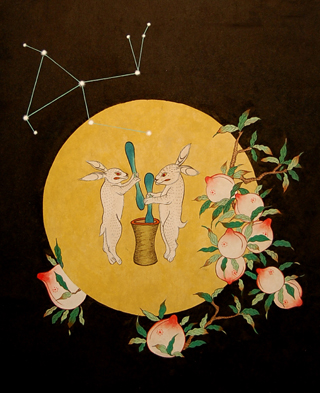The Moon Rabbit (Daltokki, 달토끼)

As the season of Chuseok approaches, the Legend of the Moon Rabbit comes to mind. This folktale, stemming from Buddhist influcence, is often told around the harvest time. It is believed that the fullest and brightest moon appears during Chuseok, symbolizing prosperity.
You might have noticed, if you’ve ever found yourself staring at the full moon, that there appears to be an image of a rabbit pounding rice cakes under a cinnamon tree within the sphere. Many countries have spun their own tales about this legendary rabbit (also well known as the “Jade Rabbit” along with many other such titles). One Korean retelling of the folktale goes like this:
There once was a village where there lived a rabbit, a fox, and a monkey who often played together. One day, the Great Emperor in the Heavens decided to test the animals’ loyalty to him. He came down from the sky disguised as a beggar and asked the animals each to bring him something to eat. The three generous animals instantly set out to honor the poor man’s request. The fox returned to the beggar with a fish; likewise, the monkey with some fruit. The rabbit, being a small and more limited animal, unfortunately was only able to bring back the grass he could gather. Ashamed at his feeble offering, the rabbit, in an act of self-sacrifice, proceeded to ignite the grass he’d gathered and threw himself into the flames to be eaten by the beggar as a meal. The action of the rabbit so touched the beggar-emperor that he placed the rabbit in the moon to become its guardian and surrounded him with smoke as a reminder to all of the rabbit’s noble death. Thus was born the Legend of the Moon Rabbit to be told for centuries to come.
There are several significant symbols within this touching folktale. The first is the rabbit itself. Rabbits are said to be symbols of fertility, complementing Chuseok’s purpose of making supplications for a bountiful harvest. Another symbol is that of the smoke that was placed around the rabbit in the moon by the emperor. As mentioned earlier, the smoke has been interpreted by some as appearing to be a gyesu tree. Gyesu trees are known for their sturdiness and longevity of life and their bark is also used to make cinnamon, a spice that has long been used for medicinal purposes. Longevity is something most of us long for, especially when surrounded by those dearest to us during the holiday season. The rice cake, which the rabbit appears to be making beneath the tree (sometimes the tales include two rabbits, reminding us of coming together with our families and preparing food for the holidays) is also a symbol in that rice cake is a Korean food staple or an “essence of life,” another theme of abundance of harvest.
Now that you know the story of the moon rabbit, you’ll have something to ponder this Chuseok season as you take a moment to gaze up at the moon on a cool, autumn night. Perhaps you’ll even see the courageous rabbit there, faithfully crafting his rice cake beneath the sturdy branches of a gyesu tree.
THE AUTHOR
Eden has been living in Korea since 2014 and enjoys reading, writing, snowboarding, and enchanting the locals with her violin when she can manage to find a spare minute away from her editing responsibilities at the Gwangju News. Eden became Managing Editor in September 2017.








One thought on “The Moon Rabbit (Daltokki, 달토끼)”